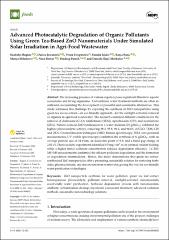Advanced Photocatalytic Degradation of Organic Pollutants Using Green Tea-Based ZnO Nanomaterials Under Simulated Solar Irradiation in Agri-Food Wastewater

View/
Date
2025Author
Bognár, Szabolcs
Jovanović, Dušica
Despotović, Vesna
Jakšić, Sandra
Panić, Sanja
Milanović, Marija
Finčur, Nina
Putnik, Predrag
Šojić Merkulov, Danijela
Metadata
Show full item recordAbstract
The increasing presence of various organics poses significant threats to aquatic
ecosystems and living organisms. Conventional water treatment methods are often insufficient, necessitating the development of powerful and sustainable alternatives. This
study addresses this challenge by exploring the synthesis of ZnO nanoparticles using
green tea leaves extract—an eco-friendly approach—for the sunlight-activated removal
of organics in agri-food wastewater. The research examined different conditions for the
removal of clomazone (CLO), tembotrione (TEM), ciprofloxacin (CIP), and zearalenone
(ZEA). Nitrate-derived ZnO synthesized in a water medium (N-gZnOw) exhibited the
highest photocatalytic activity, removing 98.2, 95.8, 96.2, and 96.6% of CLO, TEM, CIP,
and ZEA. Characterization techniques (XRD, Raman spectroscopy, SEM, zeta potential
measurements, UV–visible spectroscopy) confirmed the synthesis of N-gZnOw, with an
average particle size of 14.9 nm, an isoelectric point of 9.9, and a band gap energy of
2.92 eV. Photocatalytic experiments identified 0.5 mg/cm3 as an optimal catalyst loading,
while a higher initial pollutant concentration reduced degradation efficiency. LC-ESIMS/MS measurements confirmed the efficient pollutant degradation and the formation
of degradation intermediates. Hence, this study demonstrates that green tea extractsynthesized ZnO nanoparticles offer a promising, sustainable solution for removing herbicides, pharmaceuticals, and mycotoxins from wastewater, paving the way for eco-friendly
water purification technologies.
